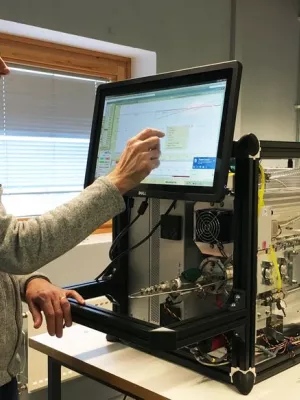
Erik Swietlicki
Professor

Size-Resolved Respiratory Tract Deposition of Sub-Micrometer Aerosol Particles in a Residential Area with Wintertime Wood Combustion
Författare
Summary, in English
Particle size distributions and hygroscopic growth were studied in a town in Sweden with extensive emissions from wood combustion. The average deposited fraction of particle number, surface area and volume dose in the human respiratory tract was estimated using the data set, as well as the typical deposition pattern of the two dominant particle source types: wood combustion and traffic exhaust. As far as we know, this is the first report on the deposited fraction and hygroscopicity of ambient particles from domestic wood combustion in the literature. The use of PM2.5 as a substitute for the deposited dose was also tested. Source/receptor modeling and the hygroscopicity measurements showed that wood combustion and traffic exhaust are dominant sources, and that these particles have a low water uptake. Number fractions of 38 and 69% of the wood combustion and traffic particles, respectively, were deposited in the respiratory tract, and 53% of the particles were deposited as an average for the whole period. The deposited fraction of the surface area and volume dose was also calculated for wood combustion particles, with the result being 22% for both parameters. The results also revealed that the PM2.5 average over more than 10 hours correlated well (r(2) > 0.80) with the deposited surface area and volume dose. This means that PM2.5 can be used as proxy for the deposited dose when examining health effect relationships during short-term exposure studies if the averaging time is sufficient, while a PM2.5 proxy is not recommended for shorter averaging times.
Avdelning/ar
- Kärnfysik
- Ergonomi och aerosolteknologi
- NanoLund: Centre for Nanoscience
- MERGE: ModElling the Regional and Global Earth system
Publiceringsår
2013
Språk
Engelska
Sidor
24-35
Publikation/Tidskrift/Serie
Aerosol and Air Quality Research
Volym
13
Issue
1
Dokumenttyp
Artikel i tidskrift
Förlag
Taiwan Association for Aerosol Research
Ämne
- Production Engineering, Human Work Science and Ergonomics
- Subatomic Physics
Nyckelord
- H-TDMA
- ICRP
- MPPD
- DMPS
- Residential wood combustion
- Lung deposition
Status
Published
ISBN/ISSN/Övrigt
- ISSN: 2071-1409